The 2023 NCAA Tournament bracket has been released, which means it is time for millions of people to fill out their brackets. Although no one has ever picked a perfect bracket (which is not surprising considering the chances are 1 in about 9 quintillion if you choose randomly), it is still fun to try and predict which teams will make a deep run and which teams will fall short. However, we can get a better idea of which teams will advance and which will fall by looking at the numbers.
In the following sections, I will go over the tournament probabilities by round, best teams by region, top first round upset picks, potential sleepers and early exits, and the best final four and championship winner picks.
SABER Rankings
How the System Works
To make my predictions, I will use my college basketball rating system: SABER. Using data from College Basketball Reference, the SABER (Schedule Adjusted Basketball Efficiency Ratings) rankings are similar to many other predictive metrics in that it looks at team performance on a per-possession basis and adjusts for strength of schedule. Like many other metrics, my ratings also have adjustments for game location (most teams play much better at home) and recency.
However, the element that makes my rankings unique among other predictive metrics is opponent 3-point percentage. It has been shown that offenses are mostly responsible for their 3-point and free throw shooting percentages. This is true in both college and the NBA as defensive 3-point percentage has been shown to be very inconsistent from season to season. To account for this, my ratings substantially decrease the importance of opponent 3-point percentage and assume that opponent free throw efficiency is entirely out of the defense’s control. It is true that defenses can influence opponent 3-point shot selection by forcing difficult off-the-dribble perimeter shots with little time on the shot clock, so I do attribute a small share of opponent 3P% to the defense. However, the efficiency is still mostly out of the defense’s hands. I will acknowledge that there are some notable exceptions to this trend. For example, Houston’s defense has been 15 in opponent 3P% for 5 straight season. Still, examples like this are exceedingly rare. As a result, teams that have a very low opponent 3-point percentage (like Tennessee and Auburn) will be rated worse in SABER compared to other predictive metrics while teams that allow a higher opponent 3-point percentage (like Xavier and Marquette) will be rated better compared to other metrics.
Probabilities
Using my rankings, I created a table showing the probability of each team reaching each round. According to my SABER rankings, UCLA, Houston, and Texas are the biggest favorites in this year’s tournament. This is difficult to digest as one big table, so I will go in depth on different regions and potential upsets or sleepers in the following sections.

Rankings by Region
South Region
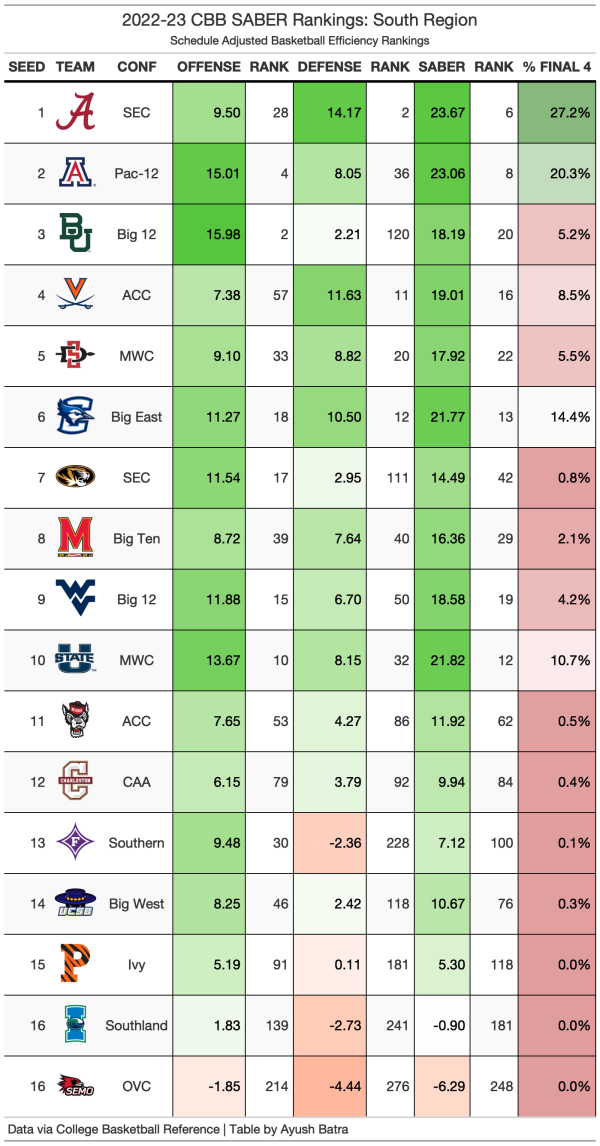
The South region is led by Alabama and Arizona, both of which are realistic candidates for the national championship. However, after that this region gets weird. According to SABER, both 6 seed Creighton and 10 seed Utah State are rated higher than 3 seed Baylor, 4 seed Virginia, and 5 seed San Diego State. Baylor has an amazing offense, but their defense is not championship level. Meanwhile, Virginia has struggled at times offensively. In late February, they scored just 57 against Notre Dame and 48 against Boston College, both of whom have sub-100 ranked defenses on KenPom. San Diego State is good, but their offense is not up to par with either Creighton or Utah State.

Utah State is one of the biggest differences between my rankings and other predictive metrics. KenPom also has Utah State ranked better than their seed indicates, but I think SABER is the only metric with Utah State in the top 10. This is because Utah State had the 211th ranked 3-point defense and 299th ranked opponent free throw percentage. My model decreases the impact of both of these, making Utah State look better in my rankings.
Another thing to watch is the first round matchup between Maryland and West Virginia, a game that pits two top 30 teams against each other for the chance to play Alabama in the next round.
Midwest Region

Outside of Houston, Texas, and Xavier, the Midwest region looks very weak. 4 seed Indiana has been inconsistent lately, losing to middling teams in Michigan State, Northwestern, Iowa, and Penn State in February. Miami’s interior defense has been bad this season (261st ranked opponent 2-point FG%), and a potentially injured Norchad Omier will only make their weakness worse.
One potential first-round matchup is Iowa State against Mississippi State (if they win on Tuesday). Both teams aren’t great on offense, but rank in the top 20 defensively, which would make for a super low scoring game.

There are several sites saying that Xavier is a potential upset candidate, but I disagree. Xavier has been unlucky with opponent shooting this season as they have the 282nd ranked 3-point defense. They were good in this area last season and coach Sean Miller doesn’t have a history of bad 3-point defenses, so this is likely just unlucky as opponent 3-point shooting depends mostly on the opponent. Therefore, SABER gives Xavier a top 40 defense while KenPom has them at 70th. In addition, none of their potential second round matchups look like teams that would pull off an upset.
West Region

The West region is the strongest region in the field by a wide margin. Each of the top 5 seeds in this region are top 15 teams in SABER. Kanses faces a difficult path to being a repeat champion. Despite being the 1-seed and a top 15 team, they are the 5th best team in the region! Both UConn and Saint Marys could be favored against Kansas in the Sweet 16. A potential Gonzaga-UCLA matchup in the Sweet 16 would be a matchup of top 5 teams. UCLA is the number 1 team in my rankings due to a stifling defense, but they lost star defender Jaylen Clark for the season, meaning the region is wide open. UConn has the ideal mix of a champion with great offense and good defense, not to mention the fact that they have been playing great lately.
Overall, it doesn’t look like there will be a lot of first-round upsets in this region, but the Sweet 16 and Elite 8 could provide some of the most entertaining games of the tournament.
East Region

Finally, we have the East region led by Purdue amd Marquette. This region looks the weakest according to the SABER rankings. Purdue and Marquette are championship-level teams, but after that it drops off. Kansas State has predictive metrics much closer to an 8 or 9 seed than a 3 seed, and Tennessee has struggled since the injury of point guard Zakai Zeigler. Tennessee has a very good defense, but they have benefitted hugely from their opponents shooting 26% from the 3-point line. Even if Tennessee does force opponents to consistently take difficult perimeter shots, it is unlikely that teams will continue to shoot this poorly in the future.
Duke and Kentucky have had a lot of hype lately after shaky starts to the season. Duke has won their last 9 games, but I would bet against them making a run to the Final Four in the tournament. Duke’s defense has benefitted from opponents shooting 30% from deep, and they have to face an explosive and experienced Oral Roberts team in the first round. Kentucky is ranked in the high 20’s for many predictive metrics, so their rating is in line with their seed.
FAU and Memphis have an intriguing 8-9 game, with FAU dominating UAB in the CUSA championship game and Memphis winning the AAC championship against Houston. Most predictive sites have Memphis favored against FAU, but FAU ranks higher in SABER since Memphis has benefitted from subpar opponent shooting. Nonetheless, both teams are top 30 teams.
First Round Upset Picks
Upsets: 5-8 Seeds
Most of the popular upsets in bracket picks come from 5-12 games, 6-11 games, and 7-10 games (I don’t think anyone really considers the 9-seed beating the 8-seed an upset). The 5 through 8 seeds are shown below in order of most likely to be upset to least.

The best first round upset candidates this season include Utah State, Boise State, USC, and Providence. As discussed previously, Utah State’s opponents have shot very well from deep, which is likely to regress. Additionally, Missouri is ranked at 51 on KenPom, 56 on barttorvik, and 42 in SABER. Utah State is ranked well above Missouri in predictive ratings, giving all the ingredients for an easy 7-10 upset pick.
Another, perhaps less popular, upset pick I really like is Oral Roberts over Duke. My model gives Duke just a 52% chance to win, meaning picking against them would be great value. Oral Roberts has all the qualities people look for when picking an upset: an experienced roster, great shooting, lots of perimeter shots, few turnovers, and great all-around offense. In addition, Connor Vanover (shown below) adds another component to the team defensively as he is a great shot-blocker (4th highest block rate in the country), giving Oral Roberts someone to match up with Duke’s Dereck Lively. While Duke has a 9 game winning streak, Oral Roberts holds the nation’s longest winning streak at 17 games. The only major weakness for Oral Roberts in this matchup is with rebounding as Duke should have their way on the boards. Duke is a tough matchup for Oral Roberts, but I believe Oral Roberts has all the components for a big upset.

Big Upsets: 1-4 Seeds
Upsets of 1, 2, 3, or 4 seeds in the tournament are rare and difficult to predict, but picking a correct upset can give a huge advantage in bracket pools. As shown below, the highly-seeded teams that are most likely to be upset in the first-round include Indiana, Kansas State, and Baylor.

The safest major upset pick this season is Kent State over Indiana. Kent State has a great defense, led by guard Malique Jacobs, who can both steal the ball and block shots despite being 6’3″. Kent State hasn’t been great from deep this season, but they have two guards in Sincere Carry and Malique Jacobs that can create shots. Although its a risky pick, Indiana could fall to Kent State in the first round.
Other than Indiana, two other high seeds to watch are Baylor and Kansas State. I have calculated SABER rankings and tournament probabilities since the 2015 season, and both Baylor and Kansas State have the lowest win probability for a 3-seed in the first round since 2015. They are still clear favorites, but it wouldn’t be a huge surprise to see one or both of these teams fall in the first round. Neither Montana State nor UC Santa Barbara have prolific offenses, but we have seen defensive oriented teams like Saint Peter’s last season create big upsets.
Sleepers
Every season, there is a low seed that reaches the sweet 16 despite low expectations. Last season, Saint Peter’s, Michigan, Miami, and Iowa State were double digit seeds that reached the second weekend. Who will be the surprise teams this season?
To Reach the 2nd Weekend (Sweet 16)
To find the potential sleepers in this year’s tournament, I looked at the teams seeded 5 and below with the best chance of reaching the Sweet 16.
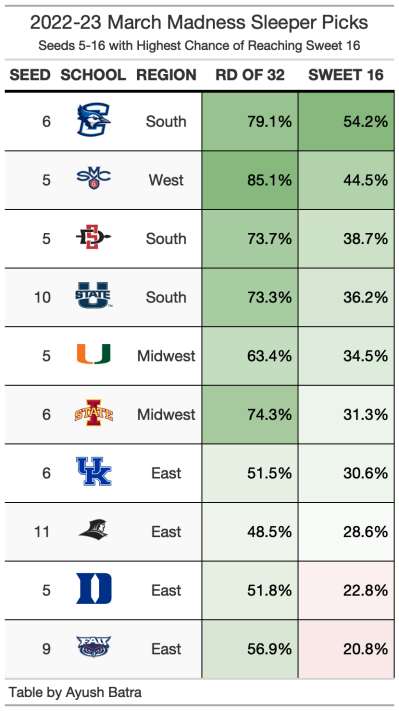
Despite being a 6 seed, Creighton is more likely than not to make the sweet sixteen. My model has Creighton favored against NC State in the first round and Baylor in a potential second round matchup, so they have a good chance of advancing to the Sweet 16. Utah State is a double digit seed that could surprise and make the Sweet 16 if they can get past Arizona in a potential 2nd round matchup. As discussed previously, Utah State has gotten unlucky with opponent perimeter shooting and has an offense that can compete with anyone. They are a good Sweet 16 sleeper pick that could have a huge payoff in bracket pools if it hits.
Both Kentucky and Providence are ranked higher than 3 seed Kansas State, which is the team the winner of UK-Providence would likely play. The SABER rankings say it is wise to pick either Providence or Kentucky in a potential 2nd round matchup vs Kansas State.

To Reach the Final Four
There has been one team seeded 5 or below to make the Final Four in every tournament since 2012. Last season, 8 seed UNC made the Final Four and in 2021, 11 seed UCLA had a surprising run to the Final Four. This season, the leading candidates to be an unexpected Final Four team include Creighton, Saint Marys, and Utah State.
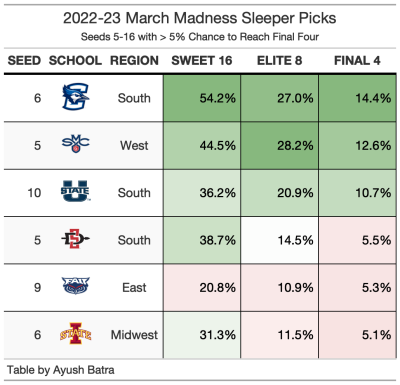
Creighton is a top 15 team in SABER, KenPom, and barttorvik despite being a 6-seed. They were highly touted in the preseason and are good on both the offensive and defensive ends. My model would have Creighton as a slight underdog against both Arizona and Alabama in potential Sweet 16 and Elite 8 games, so its possible they could make a run.
Saint Marys has to deal with the stacked West region, including a potential 2nd round matchup against a UConn team that is much better than their seed. Even if they can beat UConn, its likely they would have to go through Kansas and either UCLA or Gonzaga, so it looks like a difficult road for a Saint Marys team that has been ranked highly by predictive metrics since January.
Utah State is the only other team seeded 5 or below with at least a 10% chance of reaching the Final Four. If Utah State and Creighton can both win their first two games, they would play each other in the Sweet 16.
Early Exits
To Not Reach the 2nd Weekend (Sweet 16)
Every year, there are teams that are seeded highly but ultimately disappoint in the tournament, falling to a lower seeded team. Although these teams are usually difficult to predict, the most likely top 4 seeds to fall before the Sweet 16 include Baylor, Kansas State, and Indiana.
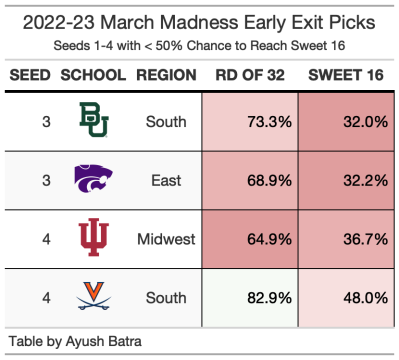
Each of Baylor, Kansas State, and Indiana have challenging first-round matchups. As stated in the section about potential first-round upsets, it is possible that any of these teams could lose in the first round. After that, these teams would either be underdogs in a 2nd round matchup or it would be a toss-up. As said before, Creighton would be favored over Baylor and either Kentucky or Providence would be favored against K-State in the 2nd round. Indiana and Virginia would be about 50-50 against Miami and San Diego State, respectively, in potential 2nd round matchups.
To Not Reach the Final Four

The same teams show up as top 4 seeds with the lowest chance of advancing to the Final Four. The most surprising team in this section, however, is Kansas. As the 1 seed in the loaded West region, Kansas shouldn’t have too difficult of a time advancing to the Sweet 16. Unfortunately for them, though, it gets incredibly difficult after that. Both UConn and Saint Marys would be favored over Kansas in a possible Sweet 16 game. Even if Kansas does advance to the Elite 8, it is likely they would have an even more difficult matchup against either UCLA or Gonzaga. Kansas is a good team, but the committee gave them a really tough draw by loading this region.
Final Four Picks
Final Four
Teams that make the Final Four are traditionally at least somewhat balanced. Since 2015, which is the earliest year that I have calculated SABER rankings, non-outlier final four teams have had a top 35 offense, top 65 defense, and top 25 overall rating. I got these numbers by finding the ranks for all 28 teams that have made the Final Four since 2015 and calculating the upper bound for outliers with the IQR formula. There have been teams that don’t satisfy the criteria, but most Final Four teams have had top 35 offenses, top 65 defenses, and top 25 overall ratings. Using this criteria, there are 17 potential Final Four candidates.

Champion
I used the same process to create a list of likely champions. There have only been 7 champions since 2015, so making assumptions from such little data is not going to be a great way for choosing a champion. For example, I did this exercise with last year’s tournament and Kansas was not included in potential National Champion teams since their defense ranked 57th when the previous worst defense for a champion was 38th. Nonetheless, we can still find qualities that can identify championship caliber teams.
The most clear characteristic among the last 7 champions was an elite offense. 6 of the 7 champions had a top 6 offense as only Villanova in 2016 ranked lower (they had the 11th ranked offense that year). This cuts down the potential number of championship teams to about a dozen. In addition, all of the last 7 champions have had at least a decent defense as all ranked better than 60th defensively. This rules out teams with prolific offenses but poor defenses like Baylor. Lastly, each of the last 7 champions have ranked 15th or better in overall SABER.
The list of teams with a top 12 offense, top 60 defense, and top 15 overall rating include:
- Houston (Midwest)
- UConn (West)
- Gonzaga (West)
- Arizona (South)
- Marquette (East)
- Purdue (East)
- Xavier (Midwest)
- Utah State (South)
However, if we ignore the 11th ranked offense for Villanova in 2016 and say that championship caliber teams must have a top 6 offense, we get the following teams:
- UConn
- Gonzaga
- Arizona
- Purdue
As I learned last year (None of Kansas, Duke, Villanova, or UNC was not included in the national champion candidates), it is unwise to make assumptions off such few data points. Therefore, I think the best way to find a champion is to simply look at the probabilities:

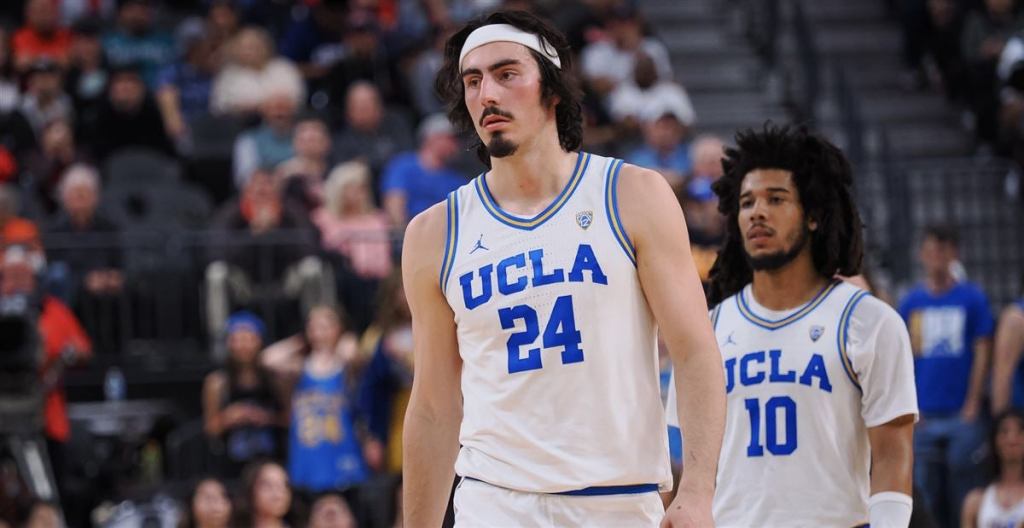
Although my model has UCLA as the team most likely to win the title, my personal pick is Houston. UCLA has depended on its defense. UCLA’s offense is good, but its not among the top 10-15 offenses in the country, which could limit its ceiling in the tournament. Meanwhile, Houston is top 15 in both offense and defense. Texas is in between UCLA and Houston with the 15th ranked offense, so its unclear whether their offense is good enough to win a title. Alabama is another team that doesn’t have an elite offense but is still very good. I wouldn’t be surprised if any of these teams win the title. In fact, according to SABER, the chance of one of these 9 teams winning the championship is 73%. I know this doesn’t narrow the list down a ton, but notice that 1-seed Kansas is not likely to win the championship and that UConn and Gonzaga are the only non top 2 seeds with a good chance to win the title. My pick for the championship is Houston, but you can’t go wrong with any of these teams.

Happy birthday
LikeLike